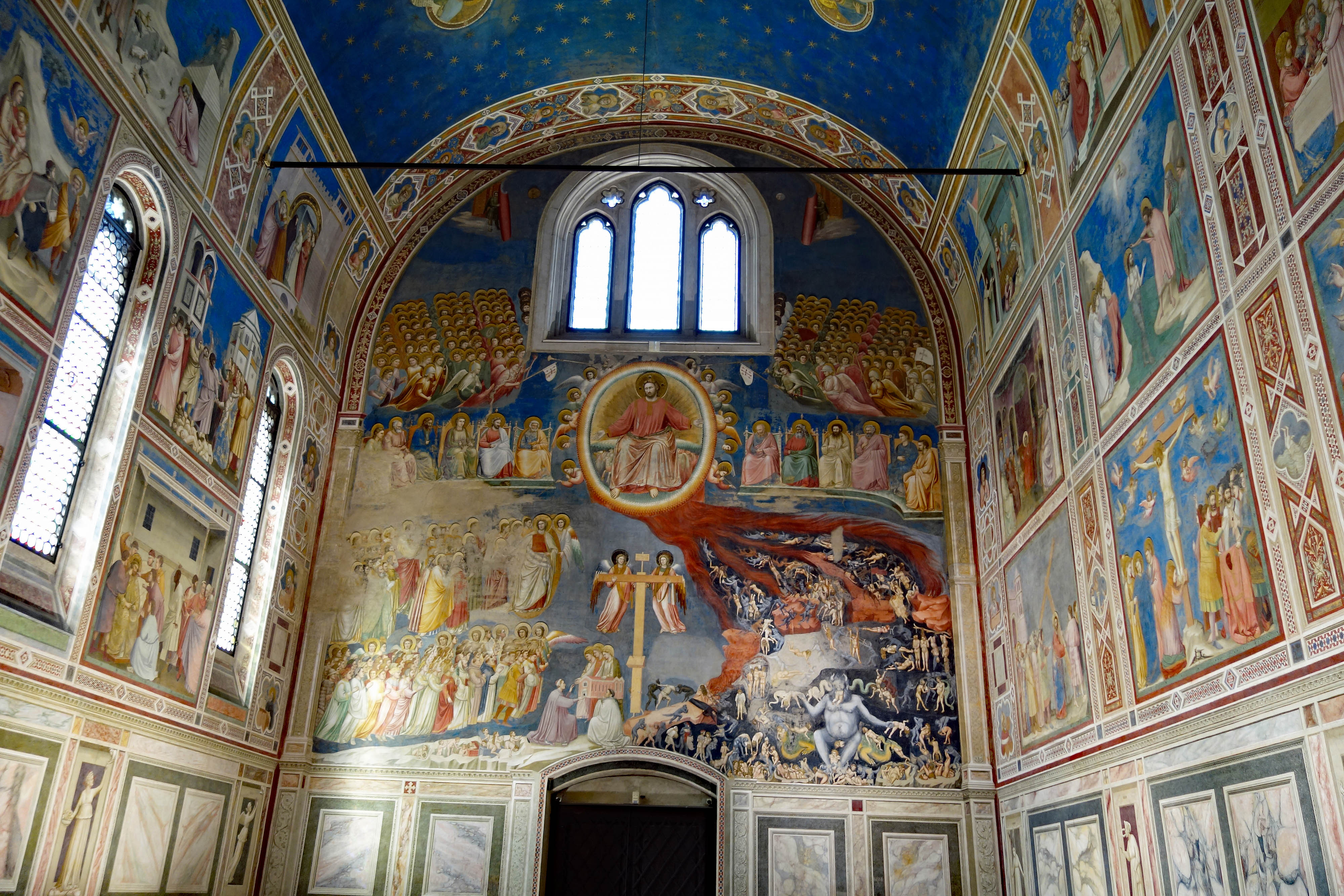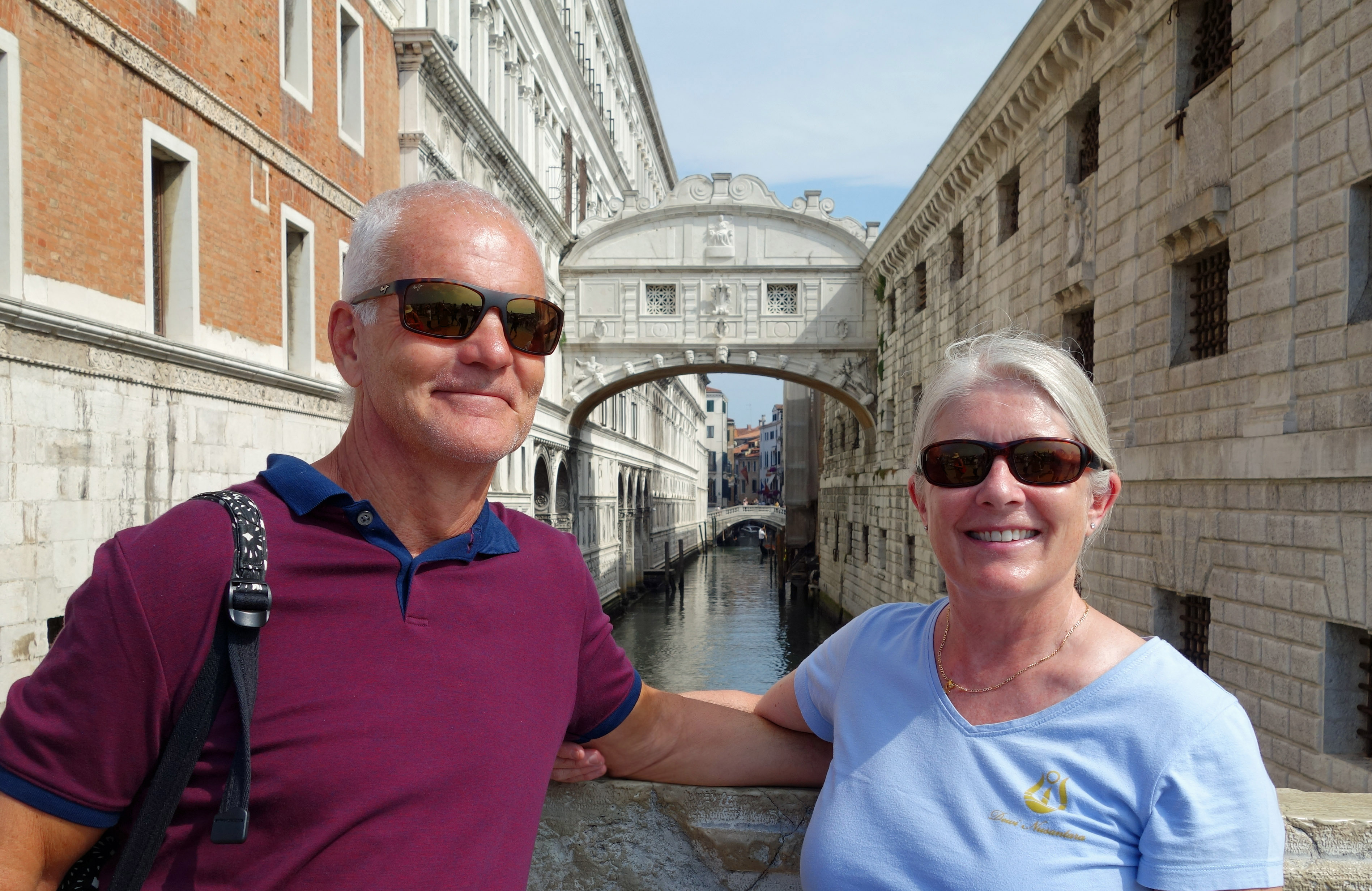
Life got busy when my cousin from Guildford came over to stay with us for 4 days in early July. Our first day trip was to Padua for us to revisit the Scrovegni Chapel which we saw for the first time in 2011. The chapel was built in 1300 by rich nobleman Enrico Scrovegni. He commissioned Giotto to decorate the chapel with frescoes, done between 1303 and 1305. The frescoes cover the interior walls and ceiling of the building completely. Above the main door is “The Last Judgement” showing Christ as Judge. He is surrounded by the Angels and Apostles, below on the left are the Blessed, to the right, the Damned are depicted as suffering eternal punishment.

Visits inside the chapel are limited to 15 minutes in a stabilized micro climate which preserves the frescoes, after first spending 15 minutes in an air conditioned waiting room watching a movie about the history of the chapel and of Giotto the artist. Given the short amount of time allowed inside, this chapel was definitely worth booking a second visit. We were in awe of this chapel the first time and equally impressed the second time around. The frescoes and the story they tell are some of the finest we have seen.



Padua is also home to Prato della Valle, the largest elliptical square in Italy and one of the largest in Europe, surrounded by 78 statues of spiritual and intellectual leaders from the 18th century. Padua is also known for it’s university, founded in 1222. It hosts the oldest botanical garden in the world (1545) and the oldest anatomy theater built in 1594. In 1678 the first woman in the world graduated from Padua university.

As we walked around Padua for a few hours, passing numerous churches, we entered Saint Anthonys Basilica. It is one of the largest churches in the world, where the relics of Saint Anthony are preserved and over 5 million pilgrims a year visit. Unfortunately, no photographs are allowed to be taken inside the basilica.
The next day we took the bus to Venice and were delighted to spend time wandering the narrow streets and seeing the attractions that bring in over 30 million tourists every year. No wonder the city is sinking!!!! We signed up for a free morning walking tour which we abandoned as soon as we realized there would be 45 people 🙁


So off we headed on our own and when we arrived at Piazza San Marco there was no lineup at St Marks Campanile so up we went. Usually there are very long lines which is why we had never done this before. The views from the top are amazing, we were able to see Venice in a whole new light.

We had admired the Bassilica di Santa Maria della Salute from St Marks Square in the past and today we made the trek over to have a closer look. This 17th century church was commissioned by Venice’s plague survivors as thanks for their salvation. As can be seen from the below photo, it is huge, notice how small the people are in the picture, and this is just the center of the church. The interior is an octagonal design with 8 chapels surrounding the open central area.



Our third and final day trip was to Verona, just over an hour away from Mirano…..well, only if there are no accidents on the highway!!! It took 90 minutes to get there and sadly, 2.5 hours to get home 🙁 Even a small accident can back up traffic for hours due to the high volume of trucks and cars using these roads. Our long journey aside, we enjoyed our time in Verona. The Verona Arena, built in the 1st century, is the 4th largest amphitheatre in Italy, still in use today hosting large scale opera performances during the summer. Originally there was an external ring surrounding the arena of which only four arches survived an earthquake in 1117. Imagine how impressive this arena was with a 31 meter high wall surrounding the inner amphitheatre.


The Della Scala family ruled Verona between the 13th and 14th century and built a group of 5 richly decorated Gothic funerary monuments called the Scaliger Tombs, celebrating 5 notable members of the Scaliger dynasty. This is a small but interesting location to visit while in Verona, down a side street from the Piazza della Erbe.

Piazza della Erbe is the main market square in Verona built during the Roman Empire. Today it hosts a colorful and popular market overflowing with food, clothing and tourist trinkets. Palazzo Maffei on the western side is decorated with statues of Greek Gods, in front of which a white marble column holds St Marks Lion, the symbol of the Republic of Venice, or as Blair commonly calls it the “Generali Insurance Lion” which Generali chose as their logo in 1848.

We walked around Verona for a few hours eventually having lunch at a restaurant tucked away on a side street, away from the crowds, before making the drive back to Mirano. Verona is a popular tourist destination and seemed almost as busy as Venice.
A few hours after arriving “home” we drove to the Venice airport for my cousin to catch her plane back to London. It was a hectic and enjoyable few days, now time for a couple of rest days…..